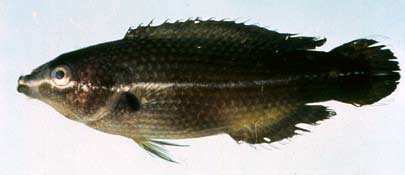| LABRIDAE |

Labrichthys unilineatus, 10.7 cm SL
(photo by Richard Winterbottom)
|
Labrichthys unilineatus (Guichenot, 1847) Tubelip Wrasse |
|
D IX, 11; A III, 10; P1 14-15; LLp 26; GR 9-10. Body moderately slender, and compressed. Dorsal profile of head convex. Mouth small, terminal; lips thick and fleshy, forming a short tube when mouth closed; upper jaw with 2 pairs of incurved canines anteriorly, and a large canine posteriorly; lower jaw with a pair of canines anteriorly, followed by 3-5 small teeth. Lateral line complete, angling sharply downward beneath posterior part of dorsal fin to straight peduncular portion. Head scaled, except for sheath over base of upper lip, preorbital, and chin. Caudal fin strongly rounded; pelvic fins very long in males. Color: females yellowish brown with light blue markings on scales; 2 narrow blue-white stripes on body, the major stripe passing from snout through lower edge of eye and ending in center of caudal fin; the second from chin to ventral caudal-fin base; median fins edged in light blue. Males dark olive with blue longitudinal lines on body, a broad yellow area in pectoral region; median and pelvic fins edged in bright blue. Size: maximum length about 17.5 cm. Distribution: Indo-Pacific, from East Africa to Micronesia and Samoa. Remarks: found in sheltered coral-rich habitats at depths of 0.5-10 m. Feeds on coral polyps, particularly staghorn Acropora |
|
|